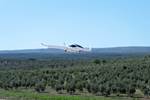Lilium Phoenix 2 demonstrator achieves main wing transition
The Lilium Jet demonstrator has now achieved transition from hover to wing-borne flight across the entire main wing while remaining stable, behaving as predicted via Lilium’s Flight Dynamics Model.

Photo Credit: Lilium
It was announced on May 31 that ’s (Munich, Germany) technology demonstrator, Phoenix 2, for the Lilium Jet, has achieved main wing transition. The company claims that it is the first full-size electric jet aircraft to transition from hover to wing-borne flight, a landmark moment for Lilium and for electric aviation.
From a flight physics perspective, completing transition means the airflow going over the flaps attached and becomes smooth, enabling the lift to be generated by the wing (as in conventional fixed-wing aircraft), rather than by the engines (which is the case during the hovering phase).
Phoenix 2 has now achieved this milestone across the entire main wing while, most importantly, remaining stable and behaving as predicted by Lilium’s proprietary Flight Dynamics Model.
“Main wing transition is a huge step forward on our path to launch and it validates our Flight Dynamics Model,” Matthias Meiner, Phonex chief engineer and Lilium co-founder emphasizes. “Full credit goes to the Lilium team who worked so hard to get us here, and who remain laser-focused on the rest of the Flight Test Campaign.”
Lilium says it will continue its Flight Test campaign throughout the summer, expanding the flight envelope further, including transition of the forward canards and high-speed flights.
In addition, according to , Lilium and (Philadelphia, Pa., U.S.) have agreed to collaborate on the advancement of lithium metal technology for use in high-performance battery cells. The collaboration is an important step towards securing Lilium’s future access to the high-performance battery cell technology that will power Lilium Jets.
Related Content
-
Joby conducts FAA testing, moves into final certification
Successful static loading testing of tail structure and Type Inspection Authorization by FAA pilots moves Joby closer to its 2025 targets.
-
Infinite Composites: Type V tanks for space, hydrogen, automotive and more
After a decade of proving its linerless, weight-saving composite tanks with NASA and more than 30 aerospace companies, this CryoSphere pioneer is scaling for growth in commercial space and sustainable transportation on Earth.
-
Aerospace prepregs with braided reinforcement demonstrate improved production rates, cost
A recent time study compares the layup of a wing spar using prepreg with A&P’s TX-45 continuous braided reinforcement versus traditional twill woven prepreg.






